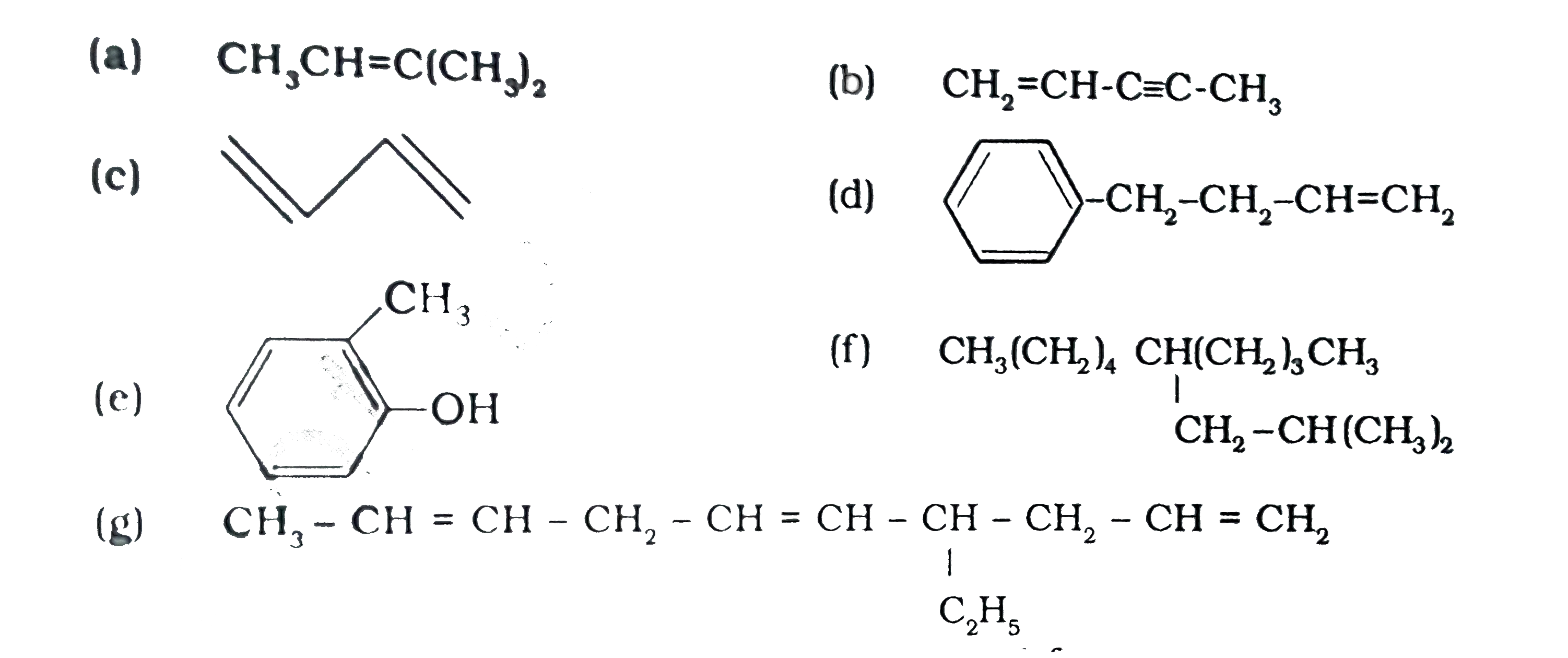Name of the following as substituted derivatives of ethylene.
(a) CH3−CH=CH−CH3
(b) CI2C=CHCI
(c) (CH3)2C=CH2
(d) (CH2=CH)2C=CH2
(e) (CH2=CH)−CH=CH−(CH=CH2)
Use symmetrical (sym) when each carbon of the (C=C) has same substituents an unsymmetrical (unsym) when both substituents are on the same C atom.
a. sym − Dimethylethylene
b. Trichloroethylene
c. unsym− Dimethyl ethylene
d. unsym − Divinyl ethylene
e. sym − Divinyl ethylene
Topper's Solved these Questions
- ALKENES AND ALKADIENESBOOK - CENGAGE CHEMISTRYCHAPTER - ALKENES AND ALKADIENESEXERCISE - SOLVED Example
62 Videos
- ALKENES AND ALKADIENESBOOK - CENGAGE CHEMISTRYCHAPTER - ALKENES AND ALKADIENESEXERCISE - EXERCISES
29 Videos
- ALKANES AND CYCLOALKANESBOOK - CENGAGE CHEMISTRYCHAPTER - ALKANES AND CYCLOALKANESEXERCISE - Archives
13 Videos
- ALKYNESBOOK - CENGAGE CHEMISTRYCHAPTER - ALKYNESEXERCISE - Exercises (Archives - Analytical and Desriptive Type)
4 Videos
Similar Questions
Knowledge Check
The IUPAC name for CH3CH2CH(CH=CH2)CH2CH2CH3 is
A4-EthenylheptaneB3-n-propylhex-1-eneC3-EthenylheptaneDNone of theseWrite the IUPAC name
A5 - ethyl - 2, 6 - dimethyl dec - 4 - eneB3 - ethyl - 5, 6 - dimethyl dec - 4 - eneC2 - ethyl - 5, 6 - dimethyl dec - 4 - eneD5 - ethyl - 2, 5 - dimethyl dec - 4 - eneWhich is the most suitable reagent amon the following to ditinguish compoun (C) from the rest of the compounds ?
(A) CH3C≡CCH3,(B)(CH3CH2−CH2CH3
(C) CH3CH2C≡CH , (D) CH3CH=CH2ABr20 in CCl4BBr2 in CH3COOHCAlkaline KMnO4DTollen's reagent
Outline the preparationof the following compounds using a nucliphileic subsituationr reaction.
a. CH3OC(CH3)3
b. CH3C≡CH2CH3
c. CH3CH2CH2N(CH3)2
d. C6H5CH2OCOCH3
e. CH3CH2CH2CH2NO2
f. CH3CH2CH2Cn
g. C6H5CH2N⊕≡Co−
h. CH3CH2−O−N=0
View SolutionWrite IUPAC names of the following compounds : (a) CH3CH=C(CH3)2
(b) CH2=CH−C≡C−CH3
(c )
(d)
(e )
CH3(CH2)4CH(CH2)3CH3 ∣ CH2−CH(CH3)2
View SolutionName the functional groups present in the following compounds.
(a) CH3COCH2CH2CH2CH3 , (b) CH3CH2CH2COOH
(c ) CH3CH2CH2CH2CHO , (d) CH3CH2OH
View SolutionWhich is a tertiary alkyl halide in the following?
Explain with reasons.
(a) CH3−(CH2)2−CHCl−CH3
(b) (CH3)3CI
(c) CH3−CH2−CCl2−CH3
(d) (CH3)3C−CHBr2
View SolutionSelect the alkyl halide and nucleophile that will give each of the following products.
(a) CH3−CH2−CH2−NH2
(b) CH3−CH2−O−CH2−CH3
(c) CH≡C−CH2−CH2−CH2
(d) (CH3)2CHS(CH3)2
(e) C6H5−O−CH2−CH3
View Solution

.PNG)